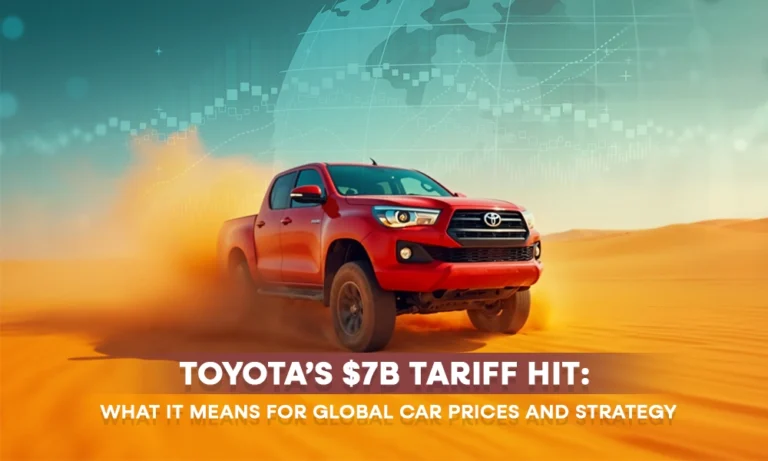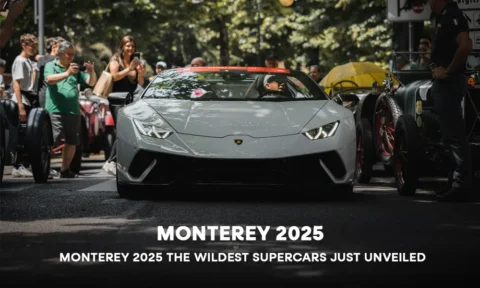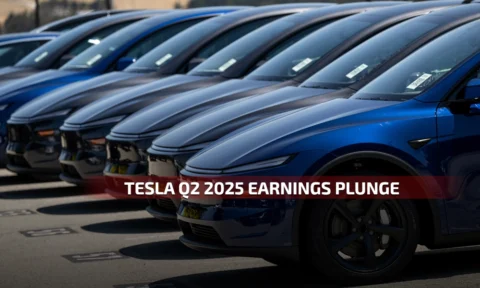President Donald Trump’s comprehensive cross-border tariff measures have disrupted the world economy, leading to firms having to increase prices on their commodities. The latest to feel the heat of these tariff wars is automotive giant Toyota. The company has sounded the alarm on a projected $7 billion profit hit from newly imposed U.S. tariffs. This has also forced the Japanese giant to rethink its supply chain, production footprint, and long-term resilience. Wondering how Toyota is going to deal with the financial fallout? Let’s take a look.
Table of Contents
- The Numbers Behind the Shock
- What’s Driving the Damage?
- Strategic Response: Adaptation in Motion
- Bigger Than Toyota: Industry-Wide Ripples
- What This Means for Future Buyers
The Numbers Behind the Shock
As per news reports, Toyota has revised its forecast to slash its full-year operating profit by 16%, projecting it at ¥3.2 trillion ($21.7 billion) instead of the previously expected ¥3.8 trillion. The tariff hit—¥1.4 trillion ($9.5 billion)—is the largest estimate issued by any automaker after the tariffs were announced.
- First-quarter operating profit: ¥1.17 trillion, down 11% year-over-year
- North American operations: Swung to a ¥63.6 billion loss, compared to a ¥100.7 billion profit last year
- Tariff impact in Q1 alone: ¥450 billion
What’s Driving the Damage?
The tariffs put in place by the Trump administration target imported vehicles and parts, apart from other goods, hitting Toyota’s cross-border operations hard. Toyota’s manufacturing units are spread across Japan, the U.S., Canada, and Mexico, which means it faces levies not just on exports but also on intra-regional shipments.
Even with a new U.S.–Japan trade pact reducing tariffs from 27.5% to 15%, the timeline for implementation remains unclear. This uncertainty heightens the pressure on Toyota’s margins and planning.
Strategic Response: Adaptation in Motion
Despite the turbulence, Toyota isn’t standing still. The company is already adapting to the change:
- Supply Chain Overhaul: Toyota is actively revising its supply routes for U.S.-bound vehicles, aiming to reduce exposure to tariff-heavy pathways.
- Domestic Investment: A new vehicle plant is planned in Japan, set to begin operations in the early 2030s—a bold move in a shrinking domestic market.
- Hybrid Surge: Toyota’s hybrid lineup continues to drive demand, with record global sales in the first half of 2025—5.5 million units, up 7.4% year-over-year.
Bigger Than Toyota: Industry-Wide Ripples
While Toyota appears to be taking the biggest hit in the automotive sector globally, it’s not alone. GM, Ford, Stellantis, Honda, Nissan, and Subaru have all flagged multi-billion-dollar tariff impacts. The sector, which accounts for 8% of Japan’s jobs and a third of its exports to the U.S., is expecting prolonged volatility.
What This Means for Future Buyers
For prospective car buyers in the US, Toyota’s $7B tariff hit isn’t just a headline—it’s an indication of what lies ahead. The impact may be felt sooner than expected as prices could creep up, especially on popular hybrids and imported models, as Toyota deals with rising costs. You might also notice fewer choices on the lot or longer waits for the exact trim you want. It’s not just about supply chains—it’s also about how those behind-the-scenes shifts affect your options, your budget, and your timing.
In the auto market, every dollar counts, and even small changes can make a big difference to how much you spend on your next ride. For more information https://news.dealershipguy.com/p/toyota-projects-1-3b-tariff-shakeup-for-april-and-may-alone-2025-05-09







